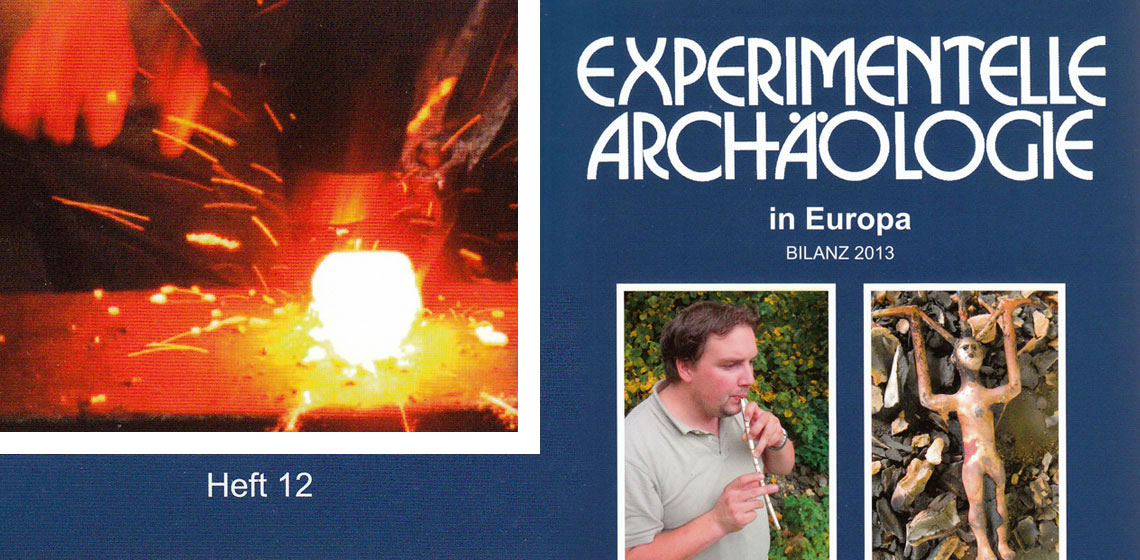
Experimentelle Archäologie in Europa. Bilanz 2013 published by Gunter Schöbel and the European Association of Archaeology by Experiment e.V. is the product of the experimental archaeology conference AEAS/GAES, held between the 4th - 7th October 2012, Switzerland. The presented papers cover the period from the Mesolithicum to the Middle Ages, with topics including experiments, education and theory of archaeology. As a result, the book invites all readers to participate in active thinking and active experiments in experimental archaeology.
The book is divided into three main topics: Experiments; recreational archaeology; teachings and theory. This gives a first overview of the contents, making it easier for readers to select a section of their own interest. The first theme, experiments, includes research on birch tar and the question of when it was used first time in history. Another experiment focuses on how radiocarbon dating (Carbon-14) can reveal information on nutrition, extracted from food crusts found inside and outside of cooking pots. The last article describes in detail the obstacles and difficulties that purple (purpur) dye vats brought with the process of extracting it in ancient times. Of noteworthy is the thorough examination of the sea snail Bolinus Brandaris (purple dye murex) that was being used for extracting the dye, along with the clear methodological approach that was applied.
The second part of the book is dedicated to recreational archaeology. This includes essays concerning building a mammoth flute; recreating a royal Celtic couch; and, a silver cup of Pettstatt. Additionally, comprehensive military archaeology was recreated by re-enactors, who tested weapons and military strategies and examined those. The experiments stood under the typical questions of possibility and understanding of resources. For example, the recreation of the royal Celtic couch revealed that only three to five handcrafters were required to construct it. The military experiment revealed that much training and equipment, which was time and resource consuming, was needed to succeed in battles.
Finally, the third part of the book offers insight on the teachings and theories related to experimental archaeology, and how the latter can be involved as a method of teaching through educational programs in museums. The first essay by Sylvia Crumbach, describes how museology, experimental archaeology and education can be intertwined to build a benefiting learning experience for visitors and non-scholars. Most of the papers focus on how educational environments benefit from experimental archaeology, also giving attention to tourism and event planning. This shows awareness of planning ahead and involving long-term projects, such as the Campus Galli, designed as a 40-year long project, including craftsmanship, experimental archaeology, tourism and living history.
The carefully chosen essays presented within this work are one of the greatest assets of this publication. It presents a variety of topics within the sub-discipline of experimental archaeology and represents the far-reaching connections of experimental archaeology with other fields of study. The book fulfills its aim in presenting a view on current projects within experimental archaeology. Although some essays do not provide new light on ongoing works, they conclude the possibility of carrying out further projects and research, such as the recreation of a royal Celtic couch.
The military experiment conducted by Thierry Luginbühl, lacks some questions relating to materialistic and human resources. Furthermore, it does not allow for authentic evaluation of total damage due to security concerns. Wounded or dead participants fall out of the battle. Thierry Luginbühl shows mainly issues in formation and tactics of battle. Re-enactment can determine certain problems in theoretical battle combats, however, it is not able to expose issues of the authentic battle.
The book “Experimentelle Archäologie in Europa 2013” is an interesting read for anyone who is curious about this subject, as well as for those who would like to keep up to date on new projects and theories within the field.
Book information:
Weller, U, Lessig-Weller, T., Hanning, E., Walter, P., (eds), 2013. Experimentelle Archäologie in Europa, Bilanz 2013, Heft 12, Unteruhldingen: Gunter Schöbel & Europäische Vereinigung zur Förderung der Experimentellen Archäologie e.V. European Association for the advancement of archaeology by experiment, ISBN: 978-3-944255-01-9.